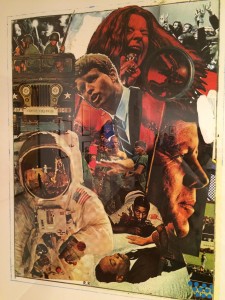By Brianna Ciniglio
Special to the Chronicle
The exhibit “From Portraits to Tweets: Imagery, Technology, and the U.S. Presidency” opened in Hofstra’s Emily Lowe Gallery on Feb. 3. It explores how the image of the president has changed throughout history.
During the years of the early U.S. presidents, people were only aware of what their leader looked like because of painted portraits. Today, the president can be seen on the television, in the papers and on every social media platform.
“When we get into the newer [exhibit] pieces, it shows that we have less control over our image,” Frantz Lucien, a graduate assistant in rhetorical studies stated. “We have cameras to catch the president at any time, unlike during Washington’s time, where he controlled his image.”
Lucien noted the representation of this idea in two pieces: one of former President Gerald Ford falling while disembarking from Air Force One in Austria, and another of former President George W. Bush making a goofy face as he tries to open a locked door in Beijing, China.
Due to applications such as Photoshop, images of the president may even be contorted. A computer in the exhibit displayed a Twitter post of President Barack Obama and Vice President Joseph Biden taking “The First Selfie.” A second image was shown with President Vladmir Putin of Russia photoshopped into the background.
Hofstra alumnus Sal Ciaravino and his wife Catherine agreed that their favorite piece was Gilbert Stuart’s portrait of Washington, which is also the image used on the dollar bill.
“[I like] the detail,” Catherine stated. “I like that it was the basis for all future pictures of Washington.”
The couple found that the exhibit highlighted the drastic changes that the presidents’ images have undergone through the introduction of new technologies and mediums.
“[The exhibit] shows how the president used to have a lot of control. These days, because of social media, they don’t have that same control,” Sal stated.
Catherine also noted that the way society views the president has also changed. “People used to want to see the president seated and looking professional. Now, we want to see him as a regular guy.”
Another highlighted piece is entitled “Lincoln vs. Obama” by Alex Guofeng Cao, which is a portrait of Lincoln entirely created by small black and white images of Obama.
The exhibit is open at the Emily Lowe Gallery until May 8.

